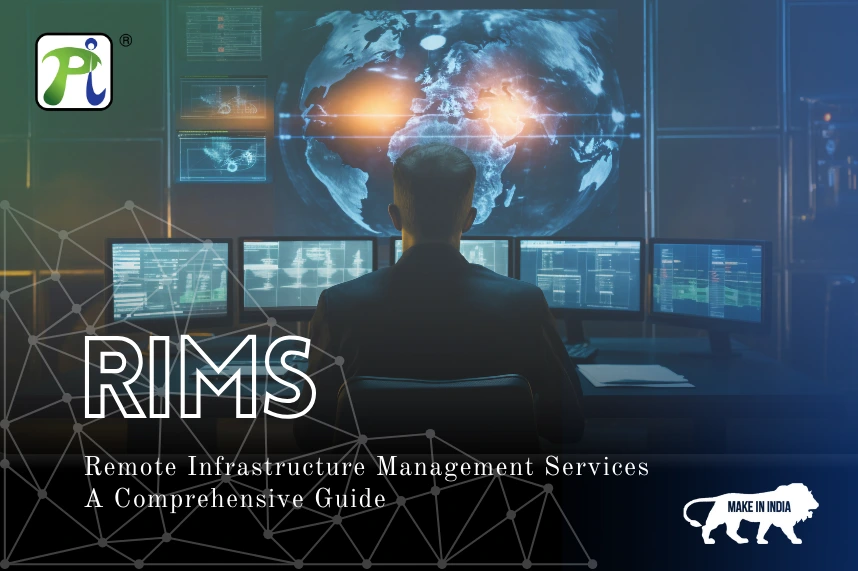We Will Get Back To You As Soon As Possible


Remote Infrastructure Management Services (RIMS) represent a comprehensive suite of solutions empowering organizations to remotely oversee and manage their IT infrastructure. This strategic approach ensures optimal performance, robust security, and cost-effectiveness, all while minimizing reliance on on-site personnel.
Remote Infrastructure Management, or RIM service, constitutes a specialized facet of IT service management. Focused on delivering remote support and maintenance, RIM addresses the intricate needs of an organization's IT infrastructure. This encompasses vigilant monitoring, proficient troubleshooting, and seamless updates to hardware and software components, fostering uninterrupted operations.
devices like computers, laptops, and servers for data storage and processing.
Inclusive of operating systems, applications, and tools facilitating user interaction with hardware.
Involving connections and devices facilitating communication within the IT infrastructure.
Representing information stored and processed by the IT infrastructure.
measures such as firewalls, antivirus software, and access controls to shield against potential threats.
The benefits of remote infrastructure management services (RIMS) are numerous and impactful. Some of the key advantages include:
RIMS ensures that businesses continue to operate as expected, even in the face of potential disruptions. When coupled with cloud-based capabilities and desktop virtualization, RIMS can completely mitigate the risks associated with disasters.
By eliminating the need for on-site staff and physical infrastructure, RIMS helps businesses reduce operational costs significantly. It also offers scalable services that can adapt to an organization's growth without substantial infrastructure investments.
RIMS provides continuous surveillance of IT systems, ensuring prompt detection of anomalies and immediate support. This proactive approach to issue resolution helps minimize downtime and maximize operational efficiency.
Outsourcing RIMS processes to remote infrastructure management providers allows enterprises to concentrate on core business activities and meet growing business requirements without inflating the IT budget. It also offers greater coordination, ease of maintenance, and increased productivity.
RIMS solutions offer seamless integration with existing IT infrastructure, steady high speed, and superior performance across all endpoints. They also provide a single pane of glass for complete real-time visibility over resources, making them essential for businesses seeking to optimize their IT operations.
RIMS ensures that businesses continue to operate as expected, even in the face of potential disruptions. When coupled with cloud-based capabilities and desktop virtualization, RIMS can completely mitigate the risks associated with disasters.
The purpose of remote management is to provide efficient and cost-effective support for an organization's IT infrastructure. This encompasses monitoring, troubleshooting, and updating hardware and software components to ensure seamless operations and maximize productivity.

The primary function of remote management is to empower organizations to oversee and monitor their IT infrastructure remotely. This capability facilitates the timely identification and resolution of issues, minimizing downtime, and maximizing operational efficiency.
When choosing the right remote infrastructure management (RIM) provider, several factors should be considered to ensure that the selected provider aligns with the organization's specific needs and offers high-quality services.
Here are some key considerations based on the search results:
The business must first consider the specific set of solutions required from the RIM service provider. Each provider offers different services, so it's essential to match the offerings with the organization's needs.
In addition to core RIM services, the right provider should offer value-added services such as security audits, alert validation, escalation, runbook management, OS patching, antivirus updates, and integration with the customer's service desk tool.
The provider should offer 24/7 monitoring of the customer's servers and operating systems, along with prompt alert validation, escalation, and management of essential tasks such as OS patching and antivirus updates.
Look for a provider that offers transparency in its service packages and offerings. This includes clear communication of the expected service range and quality, as well as result-based models that ensure accountability and performance.
The ideal provider should be able to manage and operate across multiple channels, offering services that can be tailored to match the organization's specific requirements. This includes the ability to scale services as the organization grows and its needs evolve.
Consider the provider's experience and expertise in the field of remote infrastructure management. This includes a track record of successful implementations and a deep understanding of the latest technologies and best practices.
For organizations operating globally, it's important to ensure that the RIM provider can offer efficient IT support in every location where the organization has a presence. This requires a robust and scalable global support infrastructure.
By considering these factors, businesses can make an informed decision when selecting a remote infrastructure management provider that best fits their unique requirements and offers the level of service and support, they need.
In conclusion, Remote Infrastructure Management Services (RIMS) stand as a vital strategic approach for organizations aiming to achieve optimal IT performance, robust security, and cost-effectiveness. The intricate framework of IT infrastructure, encompassing hardware, software, network, data, and security, necessitates specialized support, and RIMS emerges as a comprehensive solution.
Understanding the purpose and function of remote management underscores its significance in providing efficient and cost-effective support.
Selecting the right RIMS provider is a crucial decision, requiring a thoughtful evaluation of factors such as the specific solutions offered, value-added services, 24/7 monitoring, transparency, scalability, experience, and global support capabilities. This strategic choice ensures that the selected provider aligns with the organization's unique needs, offering high-quality services and fostering a collaborative partnership.
In the dynamic landscape of IT infrastructure management, embracing Remote Infrastructure Management Services becomes not just a strategic choice but a key driver for organizations seeking to navigate the complexities of the digital era with efficiency and innovation.
Questions? We're here to help.
©2025 Pi DATACENTERS® Pvt. Ltd. All rights reserved
